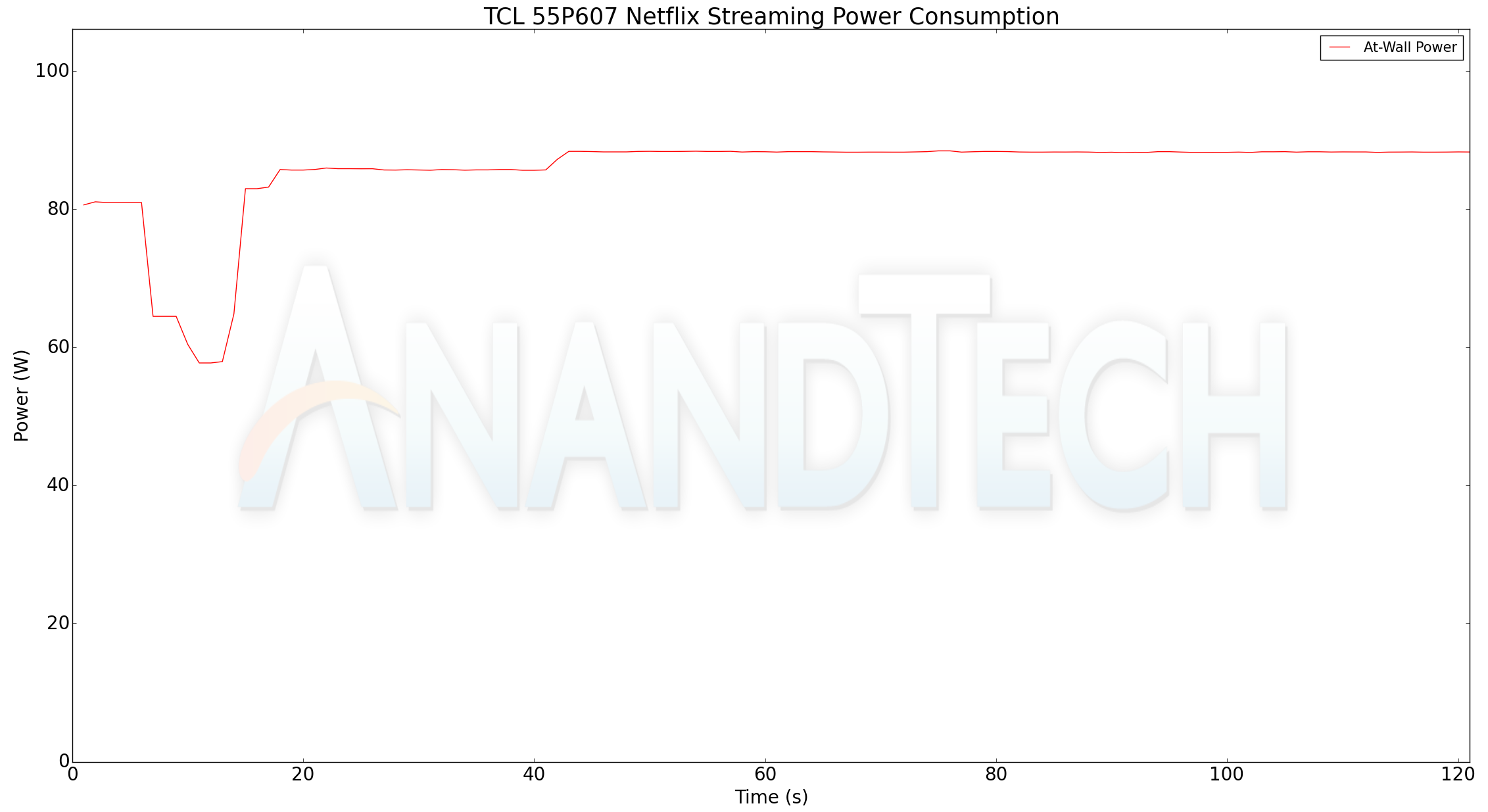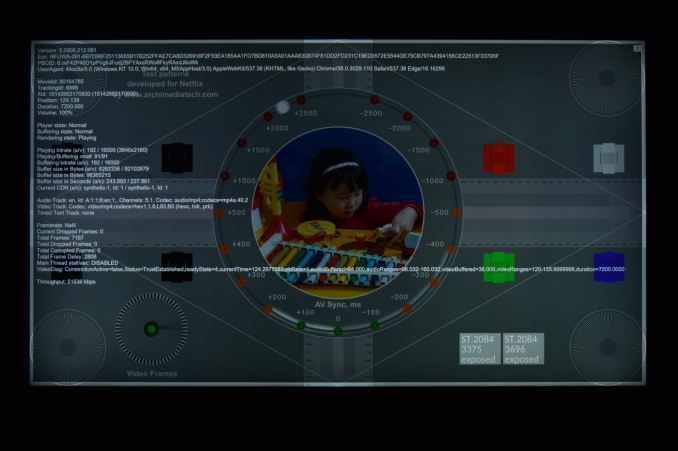A Budget Home Theater & PC Setup: 4K, HDR, UHD Blu-ray, and More
by Ganesh T S on December 26, 2017 8:30 AM ESTNetflix Streaming
We have been using Netflix's El Fuente test clip to evaluate the Netflix streaming capabilities of various HTPCs. Though it does have 4K streams at bitrates of up to 16 Mbps, it doesn't have a HDR version. Our search for a suitable test stream ended with Season 4 Episode 4 of the Netflix Test Pattern series.
The TCL 55P607's Roku platform has a Netflix app. It was able to play the 16 Mbps 4K Dolby Vision version along with Dolby Digital Plus 5.1 audio that was sent back to the receiver using the ARC feature.
Netflix 4K Dolby Vision HDR Stream in the TCL 55P607
Note that the SMPTE text in the boxes are related to the HDR metadata. As we shall see further down, the non-HDR versions of the clip have blank white boxes in that space.
The NVIDIA SATV's Netflix app plays the HDR10 version of the clip, as evident from the stream information detected by the TV.
Netflix 4K HDR10 Stream in the NVIDIA SHIELD Android TV
Our test clip is not suitable for bringing out the advantages of dynamic metadata / Dolby Vision, but, suffice to say that the SATV's Netflix HDR capabilities are compatible with every HDR TV currently in the market.
On the PC front, we have Netflix's 4K HDR working with the natie Windows Store app as well as the Edge browser. We evaluated with the Windows Store app, and the HDR version played back in all three PCs.
Netflix 4K HDR10 Stream in the Windows 10 Netflix Store App
The Windows 10 Netflix playback provides extensive insight into the available streams as well as current playback status. Note the (hevc, hdr, prk) entry corresponding to the Video Track in the debug OSD, as well as the ST.2084 boxes. Playing back the same clip with the desktop in default non-HDR mode plays back the 16 Mbps 4K stream without HDR. Note that we only have (hevc) in the Video Track codec entry, and the ST.2084 boxes are completely blank.
Netflix 4K non-HDR Stream in the Windows 10 Netflix Store App
We also tracked the power consumption of the various playback devices while streaming the HDR version. Similar to the YouTube case, we graph the TCL 55P607 Roku app separately since it involves the display power consumption also.
| Netflix Streaming - Power Consumption | |||

Similar to the YouTube streaming case, we find that the most power efficient of the lot is the ASRock Beebox-S 7200U.














191 Comments
View All Comments
rapster - Sunday, December 31, 2017 - link
Definitely. My media cabinet alone was $3k and is the budget option compared to the built-in at my last house. I really don’t get the budget complaints unless we’re dealing with kids, and thought the piece addressed quite a few things that caused me grief. Wish I read it before my last build.ganeshts - Tuesday, December 26, 2017 - link
Most speakers were re-used from my previous setup, and as such, not a part of the initial purchase list. I assume most users who upgrade can reuse existing speakers. I provided a suggestion in the concluding section.NeatOman - Tuesday, December 26, 2017 - link
I'm still content with my current setup of a plasma connected via HDMI 4:4:4 and true 8-bit to a Pentium G6950/H57/4GB w/60GB SSD that's as quiet as a cat fart. The sound IMO hasn't improved much at all unless you are going full ATMOS, my 10+ year old setup is "limited" by 5.1 96k/24-bit audio :-/ (limited by the human ear as well lol) and the speakers (that cost under a few hundred dollars) haven't really gotten any better in the last 10+ years despite what people claim (marginal at best).Plasma still has better colors than the newest quantum/nando/hyper whatever LCD/LED TV's, although due to light/color bleed either from the panel itself or just having the lights on it's blacks aren't as good on my 6+ year old Plasma. And since i only use it for movies there still isn't any noticable burn in.
But I'm definitely going to replace the PC with something Intel powered that can handle HDR10 and 4K streaming (DRM) that i believe is anything iX-7xxx and up when i get a proper OLED TV.
beisat - Tuesday, December 26, 2017 - link
Netflix on PC is never 24p - neither on Edge nor UWP App...just keep that in mind if you ever consider using a htpc on a tv...Orange14 - Tuesday, December 26, 2017 - link
I agree with others as to some of these setups not qualifying as budget HTPCs. In addition, the major fault is to assume that nobody runs cablecard tuners anymore. In my case, I still watch a fair amount of sports that requires such a set up. I've been building my own HTPCs for over five years now in a variety of different configurations. Unless one really needs the setup for gaming, the hardware requirements are modest.euskalzabe - Tuesday, December 26, 2017 - link
I'm so surprised to not even see a mention of Windows 10's horrendous HDR support. I use a HDR10 supporting TV as a monitor, with a GTX 1060, and the second I enable HDR on the desktop everything looks awfully washed out. Many have commented on this problem online forums. Sadly HDR on Windows 10 is, currently, unusable.Aikouka - Wednesday, December 27, 2017 - link
If you enable HDR in the resolution options in Windows, it will leave HDR on *at all times*. The problem is that it makes *no attempts* to adjust the content. So, it will effectively display SDR content in HDR, which doesn't turn out well. Although, I didn't notice nearly as many issues on my Sony TV as I did on my TCL TV (the Best Buy variant of the one in the this article, the P605). I wonder if that's due to the Sony TV's features including adjusting SDR content to try to make it look more like HDR?reiggin - Tuesday, December 26, 2017 - link
Not to pile on for the sake of piling on, but as others have said, this article just doesn't meet the stated objective of the headline. It's not a budget setup. It actually fails on two points -- it's neither "budget" nor "setup." To imply that it is a setup would imply that it's fully baked out. It's missing several crucial pieces of info on the speakers/audio quality (only noting the receiver and a set of surrounds is missing so much detail). And it's also missing basic details on how the whole system is configured, intended use, impressions other than technical ones, etc.All in all, this article really disappoints. It's subpar on the quality I've come to expect from Anandtech. There are glaring typos throughout that should be caught with a basic spell check. The structure of the article itself seems to bounce around. Heck, even the introductory first page just seems to be a hot mess.
I think in the end the best (admittedly unsolicited) advice that I could give is to just leave the home theater reviews to AVSForums or some other more experienced site and instead stick to reviews of individual hardware components.
Chyll2 - Tuesday, December 26, 2017 - link
Subpar article. I rather see this in a personal blog not in this site. One of the worst "budget" article I saw in a whilemr_tawan - Tuesday, December 26, 2017 - link
On the HTPC front, I guess you went for Core i5 HTPC just for SGX that's required by PowerDVD. It looks like all 7th gen Core CPU supports SGX (unlike Skylake which the lower bound is Core i5), so maybe Core i3 NUC works as well in this regard?